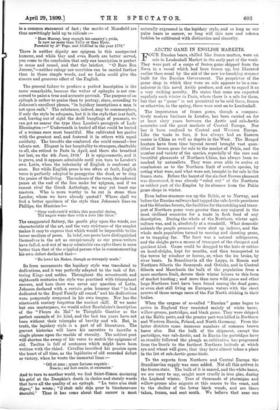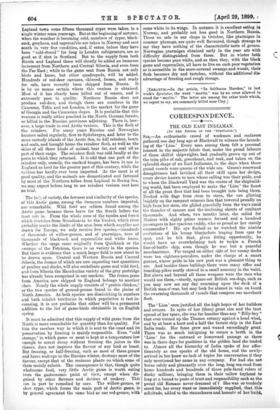ARCTIC GAME IN ENGLISH MARKETS. F OUR Russian bears, chilled like
frozen mutton, were on sale in Leadenhall Market in the early part of the week. They were part of a cargo of frozen game shipped from the Neva in a vessel which had been frozen up, but liberated earlier than usual by the aid of the new ice-breaking steamer built for the Russian Government. The proprietor of the game shop in which they were on sale appears to be a con- noisseur in this novel Arctic produce, and not to regard it as a very striking novelty. He states that some are exported regularly each winter to Paris, where there is a sale for them, but that as "game" is not permitted to be sold there, frozen or otherwise, in the spring, these were sent on to Leadenhall.
The importation of frozen game, though a compara- tively modern business in London, has been carried on for at least sixty years between the Arctic and sub-Arctic countries and the great markets of Central Europe. Nor has it been confined to Central and Western Europe. Like the trade in furs, it has always had an Eastern centre in China as well as depots in the West. The Mongol hunters have from time beyond record brought vast quan- tities of frozen game for sale to the market of Pekin, and the number and variety of the species, especially of the rare and beautiful pheasants of Northern China, has always been re- marked by naturalists. They were even able to arrive at conclusions as to the Northern limit of certain species, by noting what were, and what were not, brought in for sale in the frozen state. Before the haunt of the six-foot Reeves pheasant was discovered, it was already "ruled out" of the Northern or coldest part of the Empire by its absence from the Pekin game shops in winter.
Even before steamers ran up the Baltic, or to Norway, and before the Russian railways had tapped the sub-Arctic provinces and the Siberian forests, the facilities for the catching and trans- port of Northern game were greater than any enjoyed in the most civilised countries for a trade in flesh food of any description. During the whole of the Northern winter agri- culture was, and is, absolutely at a standstill. What domestic animals the people possessed were shut up indoors, and the whole male population turned to snaring and shooting game, or to trapping fur. The frost was a natural refrigerator, and the sleighs gave a means of transport of the cheapest and quickest kind. Game could be dragged to the huts or cabins on hand-sleighs, kept for months, and then transported to the towns by reindeer or horses, or, when the ice broke, by river boats. In Scandinavia all the Lapps, in Russia and Northern Siberia the Samoyeds and Ostiaks, and in Central Siberia and Manchuria the bulk of the population from a more southern limit, devote their winter leisure to this form of market hunting ; and more than once wild geese and other large Northern fowl have been found among the dead game, or even shot still living on European waters with the short arrows of these savage races of the Far North sticking in their bodies.
When the cargoes of so-called " Russian " game began to arrive in England they consisted mainly of white hares, willow-grouse, partridges, and black game. They were shipped at the Baltic ports, and the greater part was killed in Northern and Western Russia, Poland, and North Germany. From the latter districts came immense numbers of common brown hares also. But the bulk of the shipment, except the partridges, was sub-Arctic, and in Russia the partridges have so steadily followed the plough as cultivation has progressed from the South to the furthest Northern latitude at which rye and wheat will grow, that they have almost taken a place in the list of sub-Arctic game-birds.
To the exports from Northern and Central Europe the Scandinavian supply was soon added. Not all this arrives in the frozen state. The bulk of it is snared, and the white hares, we are sorry to say, caught most cruelly in iron gins, during the Lapland winter. Tens of thousands of ptarmigan and willow-grouse also migrate at this season to the coast, and to the shelter of the lower birch woods, and are there taken, frozen, and sent south. We believe that near one Lapland town some fifteen thousand ryper were taken in a single winter some years ago. But at the beginning of autumn, when the weather is becoming cold, numbers of ryper, black- cock, greyhens, and capercailzie are taken in Norway and sent south in. very fine condition, and, if eaten, before they have been " cold-stored " for long in London refrigerators, are as good as if shot in Scotland. But to the supply from both Russia and Lapland there will shortly be added an immense increment from Northern and Central Siberia, and even from the Far East ; while to the game sent from Russia not only birds and hares, but other quadrupeds, will be added.
Hundreds of red-deer carcases, skinned, frozen, and ready for sale, have recently been shipped from Russia. It is by no means certain where this venison is obtained. Most of it has clearly been killed out of season, and is extremely poor in quality. Northern Russia does not produce red-deer, and though there are numbers in the Caucasus, Tiflis, and not London, is the market for the game of Georgia and the Caucasian slopes. It is probable that this venison is really either poached in the North German forests, or killed in the Russian provinces adjoining. There is, how- ever, a large trade in real Arctic venison. This is the flesh of the• reindeer. For many years Russian and Norwegian hunters sailed regularly, first to Spitzbergen, and later to the more easterly islands of the Arctic Sea, to kill reindeer, bears, and seals, and brought home the reindeer flesh, as well as the skins of all three kinds of animal, bear fat, and seal oil as part of their cargo. The reindeer flesh was sold locally, at the ports to which they returned. It is odd that one part of the reindeer only, namely, the smoked tongue, has been in use in England as food for the greater part of this century, while the venison has hardly ever been imported. As the meat is of good quality, and the animals are domesticated and fattened by most of the Northern tribes from Lapland to Bering Sea, We may expect before long to see reindeer venison sent here on trial.
The lac!: of variety, the fewness and similarity of the species, of this Arctic game, among the immense numbers imported, are remarkable. .Wild fowl are seldom found among the Arctic game because these leave for the South before the frost sets in. From the whole zone of the tundra and forest which stretches from Scandinavia to the Yenisei, which river probablymarks the limits of the area from which supplies are drawn for Europe, we only receive five species,—hundreds of thousands of willow-grouse, and of ptarmigan, tens of thousands of blackcock and capercailzie and white hares. Whether the cargo came originally from Quickiock or the swamps of the Petchora, there is no variety in the species. But there is evidence that a much larger field is now about to be drawn upon. Central and Western Russia and Central Siberia, the former of which are now exporting vast quantities of poultry and ducks, will also contribute game and wild fowl, and from Siberia the Manchurian variety of the grey partridge has already been recognised in our markets. The frozen game from America now shipped to England belongs to another class. Nearly the whole supply consists of "prairie chicken,', or the two species of ground-grouse found in the plains of North America. As both species are diminishing in numbers and both inhabit territories in which population is fast in- creasing, it is not probable that either will be a permanent addition to the list of game-birds obtainable in an English spring.
• It must be admitted that this supply of wild game from the North is more remarkable for quantity than for quality. For this the careless way in which it is sent to the coast and its preservation by freezing is mainly responsible. Even "cold storage," in which game or meat is kept at a temperature low enough to arrest decay without freezing the juices in the tissues, does not improve the flavour of any bird or beast. But freezing, or half-freezing, such as most of these grouse and hares undergo in the Russian winter, destroys most of the flavour, except that of the resinous plants on which some of them mainly subsist. The consequence is that, though quite wholesome food, very little Arctic game is worth eating from the gastronomic point of view, except when dis- guised by other flavours and devices of cookery. This can in part be remedied by care. The willow-grouse, or skov. ryper, which forms the main part of Arctic game, is by general agreement the same bird as our, red-grouse, with some white in its wings. In autumn it is excellent eating in Norway, and probably not less good in Northern Russia. Those on sale in our sheps in October, like ptarmigan in summer plumage, are quite well flavoured, though strange to say they have nothing of the characteristic taste of .grouse. Norwegian ptarmigan obtained early in the year are with difficulty distinguished from these. But in winter both species become pure white, and as then they, with the black game and capercailzie, all have to live on such poor vegetation as is accessible in the snow-covered swamps and woods, their flesh becomes dry and tasteless, .without the additional dis- advantage of freezing and rough storage.
[Easerum.—In the article, "In Salthouse Marshes," in last week's Spectator, the word "martin' was by an error allowed to stand for "merlin." The latter are among the other birds which, we regret to say, are commonly killed near Cley.)























































 Previous page
Previous page